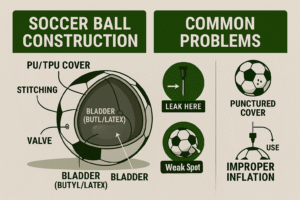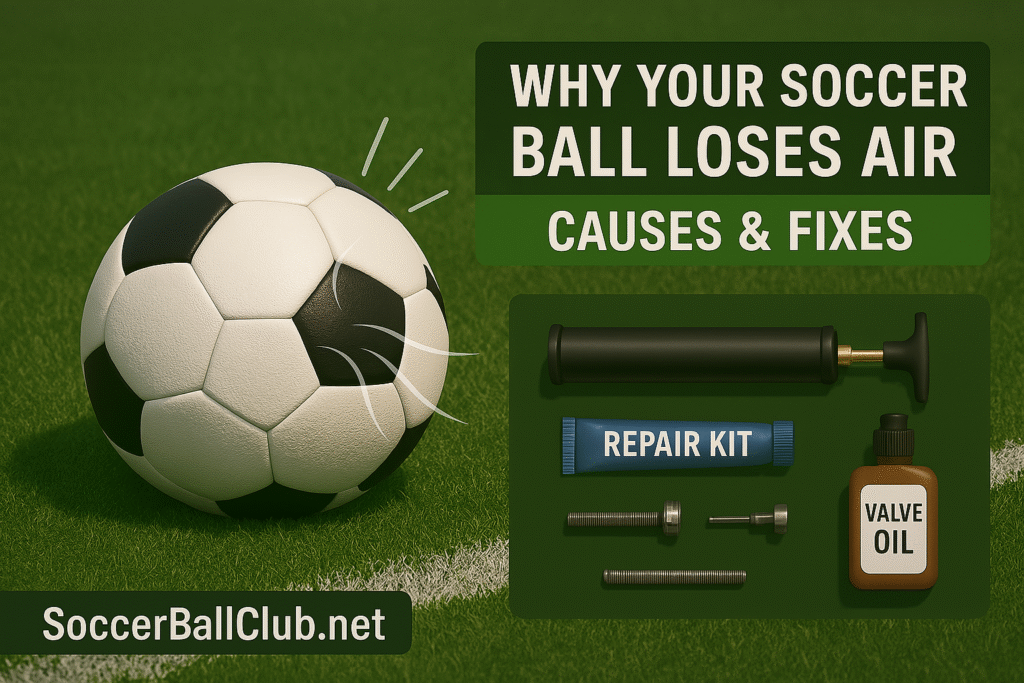Introduction
There’s nothing more frustrating than pumping your soccer ball one day and finding it flat the next. Whether you’re a weekend warrior or a daily trainer, a soccer ball that won’t hold air ruins your game.
At SoccerBallClub.net, we take air retention seriously. That’s why we’ve created this guide to help you identify why your soccer ball loses air quickly — and how to fix it.
Common Causes of Soccer Ball Air Loss
1. Punctures or Leaks in the Outer Cover
Even a tiny tear in the PU or TPU layer can cause gradual air escape.
Signs:
- You hear a faint hiss after inflation
- Air leaks around a specific spot
Fix: Locate the puncture using soapy water. If bubbles form, patch with a soccer ball repair kit or use super glue for small holes.
2. Damaged Valve Stem
The valve is where you insert the pump needle — and it’s also a weak spot.
Damage Causes:
- Forcing in the pump needle
- Moisture or debris inside the valve
- Manufacturing defects
Fix:
- Clean the valve gently using a damp cotton swab
- Use valve oil or silicone lubricant to seal minor gaps
- If broken, valve replacement is tricky — consider replacing the ball if it’s old
3. Low-Quality or Worn-Out Bladder
The bladder holds the air inside the ball. There are two main types:
- Butyl bladder: Excellent air retention (used in training balls)
- Latex bladder: Softer touch but needs frequent inflation (used in match balls)
If your ball has a latex bladder, some air loss is normal every 1–2 weeks.
4. Extreme Temperature Changes
Cold weather compresses air; heat can expand it and stress the bladder.
Tip:
- Don’t leave your ball in a hot car or freezing garage overnight
- Always store it at room temperature for best air retention

How to Detect a Slow Air Leak
Try the Soap & Water Test:
- Mix dish soap with water in a bowl
- Inflate the ball fully
- Apply soapy water to the surface and valve using a sponge
- Look for bubbles forming = air leak spot
This method works great for pinpointing small leaks.
How Often Should You Inflate a Soccer Ball?
| Bladder Type | Inflation Frequency |
|---|---|
| Butyl | Every 2–4 weeks |
| Latex | Every 5–10 days |
If you’re inflating a butyl ball every 2 days — something’s wrong.
Our Elite Grip Pro Training Ball uses a high-retention butyl bladder: View Product
How to Properly Inflate a Soccer Ball
Incorrect inflation causes both air loss and valve damage.
Follow these steps:
- Use a needle pump
- Moisten the needle before insertion
- Insert slowly at a straight angle
- Inflate to recommended PSI (usually 8.5–15.6 PSI)
📏 Always check the pressure printed near the valve or packaging.
When to Replace the Ball
Sometimes, it’s better to retire the ball than repair it.
Replace if:
- Valve is completely detached
- Bladder is punctured or leaking from multiple points
- Outer cover is separating from inner layers
Visit our store for durable replacements: SoccerBallClub Match Balls
How to Prevent Future Air Loss
1. Store Indoors
Extreme heat or cold damages the bladder and causes pressure changes.
2. Use the Right Surface
Avoid using match balls on:
- Asphalt
- Rough concrete
These surfaces damage the ball exterior.
3. Inflate Properly and Regularly
Maintain optimal pressure and don’t over-pump. Keep a ball pressure gauge handy.
4. Use Quality Balls
Cheap soccer balls are made with:
- Weak PVC outer layers
- Low-quality stitching
- Inferior bladder materials
All SoccerBallClub balls use premium PU or TPU covers, and are tested for air retention over 100 hours of play.
Recommended Balls with Superior Air Retention
Training Ball: Elite Grip Pro
- Butyl bladder, reinforced stitching, excellent for daily use
Match Ball: Precision Flight Pro
- Latex bladder, thermo-bonded, perfect for top-level games
Final Thoughts
Air loss is annoying — but it’s also preventable. With proper care, high-quality materials, and a bit of know-how, your soccer ball should keep its shape and pressure for weeks at a time.
Still having issues? It might be time to upgrade.
⚽ Explore premium balls tested for air retention at SoccerBallClub.net and enjoy the game uninterrupted.

